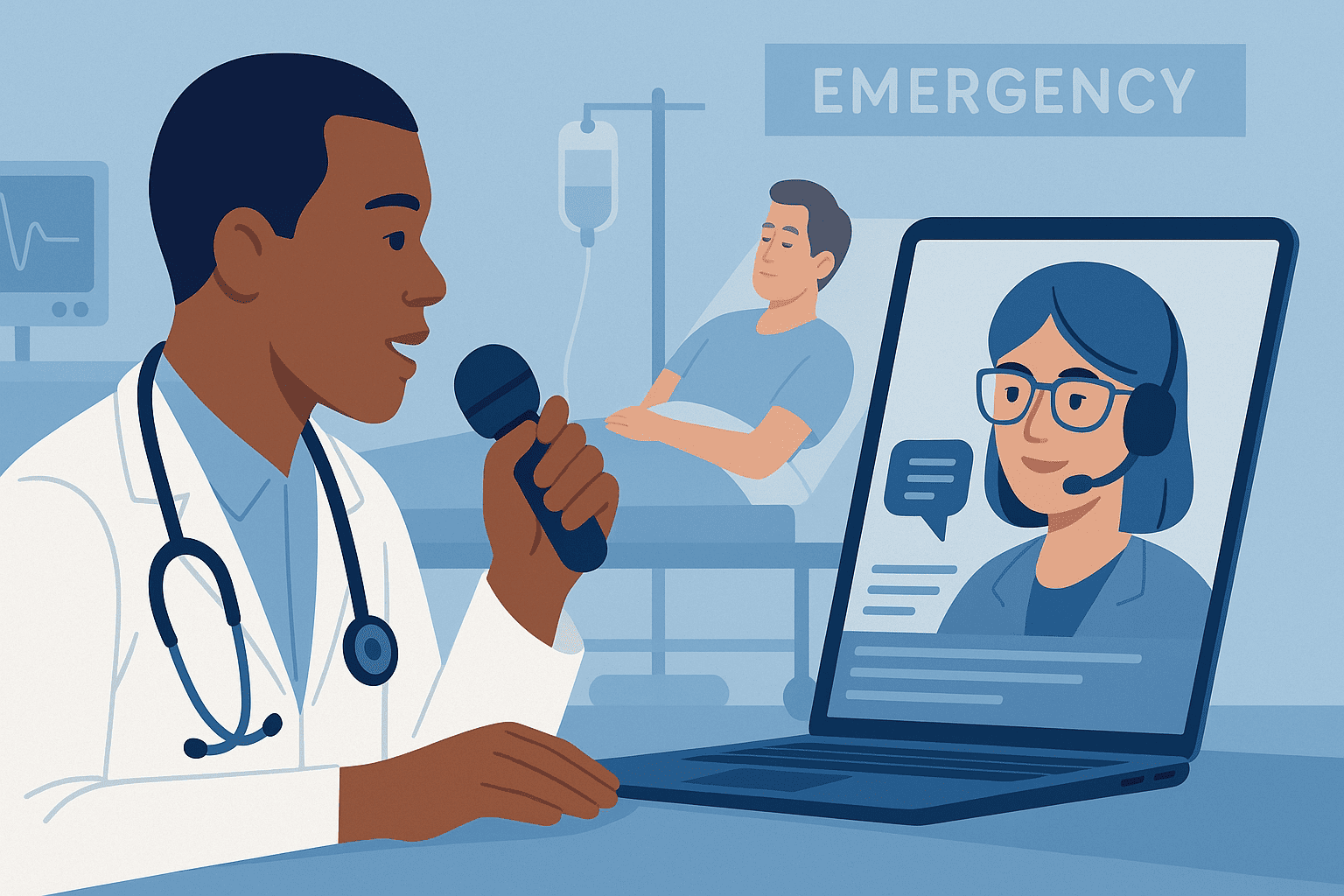Updated on: July 15, 2025
The emergency department never stops. Whether it’s trauma, chest pain, psychiatric crises, or a laceration repair, emergency physicians must think fast, act faster, and still document it all. Every second counts—and every word in the chart matters legally, clinically, and financially.
That’s why ER teams across the country are turning to DocScrib, the AI medical scribe tailored for emergency medicine. It listens during patient encounters, captures critical details in real time, and delivers clean, complete documentation—without slowing down your workflow.
Why Emergency Medicine Documentation Is Unique
In the ER, documentation isn’t just charting—it’s liability protection, clinical reasoning, and billing all in one. But it’s also:
-
High-pressure and high-volume
-
Time-constrained, with rapid patient turnover
-
Medico-legally sensitive (every note may be scrutinized)
-
Full of varied complaints and procedures
-
Constantly interrupted
Manually typing every HPI, ROS, re-eval, and procedure note? Unsustainable.
What Is an AI Medical Scribe for Emergency Medicine?
DocScrib for Emergency Medicine is a real-time, voice-powered AI scribe that automatically generates complete, EMR-ready notes while you care for patients.
It handles:
-
Acute complaint HPIs (e.g., chest pain, syncope, fever)
-
Full ROS and physical exams
-
Procedure documentation (laceration repair, intubation, sedation, splinting)
-
Re-evaluations and disposition plans
-
Critical care time and consult notes
And it does it all securely, in seconds—not hours.
How DocScrib Fits Into Emergency Department Workflows
-
Activate for each patient
DocScrib passively listens during the encounter—whether bedside, virtual, or trauma bay. -
Captures the full encounter
HPI, exam findings, orders, response to treatment, and disposition plan are all noted in real time. -
Delivers the full note
A clean, structured note is ready in under 2 minutes—fully editable and EMR-compatible. -
You move on to the next patient
No backlogged charting. No lost sleep. No compromised notes.
Why Emergency Physicians Choose DocScrib
⚡ Ultra-Fast Note Turnaround
Complete SOAP or MDM notes in <2 minutes, even during shift handoffs.
🛠️ Captures Procedures Seamlessly
Intubation, central line, sedation, lac repair, chest tube—all templated and editable.
💬 Supports High-Volume Flow
Chart without disrupting your tempo—even when managing multiple rooms.
⚖️ Improves Medico-Legal Documentation
Includes time stamps, re-evals, and ROS to support defensible documentation.
🧠 Adapts to Any Chief Complaint
From headache to hemorrhage—DocScrib understands ED terminology and context.
DocScrib Features Designed for the ED
-
🩻 Complaint-Based Templates
Chest pain, shortness of breath, abdominal pain, fever, AMS, psych, trauma, and more. -
💉 Procedure Logs
Built-in notes for laceration repair, sedation, intubation, fracture care, joint reduction, and more. -
⏱️ Critical Care Documentation
Auto-captures CC time, interventions, re-assessments, and discussions. -
🔁 Re-evaluation Tracking
Follows changes in vitals, mental status, pain scores, and response to treatment. -
📈 Disposition Planning
Includes admit, discharge, transfer, AMA, and observation documentation.
Top Use Cases for DocScrib in Emergency Medicine
-
Acute Chest Pain: HPI, risk stratification, EKG + troponin, consult, disposition
-
Psychiatric Crisis: Safety checks, suicide risk assessment, psych consult documentation
-
Laceration Repairs: Description, anesthesia, suture technique, follow-up
-
Respiratory Distress: Interventions, oxygenation, response tracking
-
Trauma Cases: Primary/secondary survey, FAST exam, spine precautions, imaging results
-
Reevaluations: Return of pain, improvement with meds, new orders
Case Study: Level 2 Trauma Center, Texas
📍 12 physicians + 8 PAs/NPs
After 30 Days Using DocScrib:
-
Cut charting time by over 60% per provider
-
Improved critical care billing accuracy
-
Reduced note completion delays during peak volume hours
-
Increased real-time re-eval documentation by 40%
💬 “I leave the shift with zero charts left. It even logs my procedures better than a human scribe ever did.”
DocScrib vs. Manual ED Documentation
| Feature | Manual Notes | DocScrib AI Scribe |
|---|---|---|
| HPI + ROS | Typed after the fact | ✅ Auto-structured instantly |
| Procedures (e.g., sedation) | Manually templated | ✅ Pre-built & editable |
| Re-Evaluations | Often skipped | ✅ Time-stamped + detailed |
| Disposition Notes | Rushed or delayed | ✅ Auto-completed |
| Time per Note | 10–20 mins | ✅ <2 mins per patient |
FAQs: AI Scribes for Emergency Medicine
Q1. Can DocScrib handle trauma or critically ill patients?
Yes—it supports trauma evaluations, FAST exams, and captures time-based critical care interventions.
Q2. Does it document procedures like intubation or sedation?
Absolutely. It includes templated notes for common ED procedures with built-in fields and modifiers.
Q3. Is it secure and HIPAA-compliant?
Yes—DocScrib is fully HIPAA-compliant and supports secure EMR integration.
Q4. What if I don’t speak clearly or am interrupted?
DocScrib is trained on emergency medicine audio patterns and filters out irrelevant background noise.
Q5. Can multiple providers use it during the same shift?
Yes, it supports multi-provider logins and documentation by shift or area (e.g., fast track, trauma bay).
Get Started with DocScrib for Emergency Medicine
-
Book your free demo
-
Select “Emergency Medicine” as your specialty
-
Customize templates for trauma, sedation, psych, and more
-
Stop documenting late—start leaving on time
Conclusion: The Smarter Way to Chart in Emergency Care
Emergency medicine is unpredictable, high-stakes, and non-stop. Your documentation needs to be just as fast and dependable.
With DocScrib’s AI medical scribe for Emergency Medicine, you get real-time notes that capture what matters most—without slowing you down.
🩺 Document smarter → Try DocScrib for Emergency Medicine
